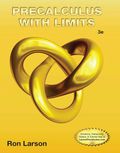
Concept explainers
(a)
The sketch a
(a)
Answer to Problem 17E
The value of the angle
Explanation of Solution
Given information:
The length (in feet) of the winning men’s discus throws in Olympics from
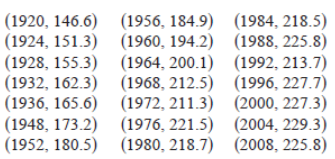
Calculation:
Scatter plot of data is shown below figure.
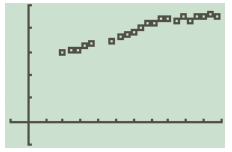
Therefore, the sketch of a scatter plot is shown in figure.
(b)
The equation of the line using straightedge to sketch the best-fitting line through the points.
(b)
Answer to Problem 17E
The equation of the line
Explanation of Solution
Given information:
The length (in feet) of the winning men’s discus throws in Olympics from
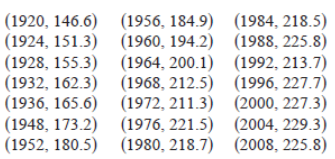
Calculation:
The initial value by the data point
Calculate the slope of line.
Using the point slope from the equation.
The linear equation is

Therefore, the equation of the line
(c)
The least square regression line that fits the data using regression feature of graphing utility.
(c)
Answer to Problem 17E
The equation of the line
Explanation of Solution
Given information:
The length (in feet) of the winning men’s discus throws in Olympics from
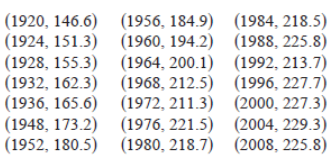
Calculation:
Using regression feature of graphing utility.
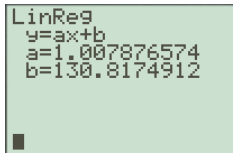
Calculate the equation of least square regression line from above graph.
The
Therefore, the equation of least square regression line is
(d)
Compare the linear model in part (b) with the linear model in part (c).
(d)
Answer to Problem 17E
The linear model in part (b) with the linear model in part (c) both models are similar.
Explanation of Solution
Given information:
The length (in feet) of the winning men’s discus throws in Olympics from
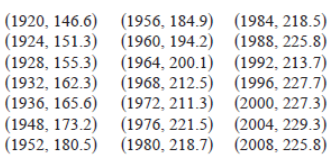
Calculation:
By comparing the model found in part (b)
From the above observation it is concluded that the both models are similar.
Therefore, the linear model in part (b) with the linear model in part (c)both models are similar.
Chapter 1 Solutions
EBK PRECALCULUS W/LIMITS
- please do Q3arrow_forwardUse the properties of logarithms, given that In(2) = 0.6931 and In(3) = 1.0986, to approximate the logarithm. Use a calculator to confirm your approximations. (Round your answers to four decimal places.) (a) In(0.75) (b) In(24) (c) In(18) 1 (d) In ≈ 2 72arrow_forwardFind the indefinite integral. (Remember the constant of integration.) √tan(8x) tan(8x) sec²(8x) dxarrow_forward
- Find the indefinite integral by making a change of variables. (Remember the constant of integration.) √(x+4) 4)√6-x dxarrow_forwarda -> f(x) = f(x) = [x] show that whether f is continuous function or not(by using theorem) Muslim_mathsarrow_forwardUse Green's Theorem to evaluate F. dr, where F = (√+4y, 2x + √√) and C consists of the arc of the curve y = 4x - x² from (0,0) to (4,0) and the line segment from (4,0) to (0,0).arrow_forward
- Evaluate F. dr where F(x, y, z) = (2yz cos(xyz), 2xzcos(xyz), 2xy cos(xyz)) and C is the line π 1 1 segment starting at the point (8, ' and ending at the point (3, 2 3'6arrow_forwardCan you help me find the result of an integral + a 炉[メをメ +炉なarrow_forward2 a Can you help me find the result of an integral a 아 x² dxarrow_forward
 Calculus: Early TranscendentalsCalculusISBN:9781285741550Author:James StewartPublisher:Cengage Learning
Calculus: Early TranscendentalsCalculusISBN:9781285741550Author:James StewartPublisher:Cengage Learning Thomas' Calculus (14th Edition)CalculusISBN:9780134438986Author:Joel R. Hass, Christopher E. Heil, Maurice D. WeirPublisher:PEARSON
Thomas' Calculus (14th Edition)CalculusISBN:9780134438986Author:Joel R. Hass, Christopher E. Heil, Maurice D. WeirPublisher:PEARSON Calculus: Early Transcendentals (3rd Edition)CalculusISBN:9780134763644Author:William L. Briggs, Lyle Cochran, Bernard Gillett, Eric SchulzPublisher:PEARSON
Calculus: Early Transcendentals (3rd Edition)CalculusISBN:9780134763644Author:William L. Briggs, Lyle Cochran, Bernard Gillett, Eric SchulzPublisher:PEARSON Calculus: Early TranscendentalsCalculusISBN:9781319050740Author:Jon Rogawski, Colin Adams, Robert FranzosaPublisher:W. H. Freeman
Calculus: Early TranscendentalsCalculusISBN:9781319050740Author:Jon Rogawski, Colin Adams, Robert FranzosaPublisher:W. H. Freeman
 Calculus: Early Transcendental FunctionsCalculusISBN:9781337552516Author:Ron Larson, Bruce H. EdwardsPublisher:Cengage Learning
Calculus: Early Transcendental FunctionsCalculusISBN:9781337552516Author:Ron Larson, Bruce H. EdwardsPublisher:Cengage Learning





